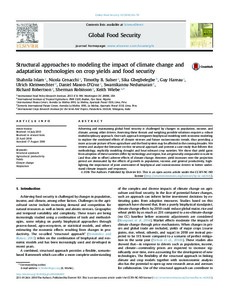| dc.contributor.author | Islam, S. |
| dc.contributor.author | Cenacchi, N. |
| dc.contributor.author | Sulser, T.B. |
| dc.contributor.author | Gbegbelegbe, Sika |
| dc.contributor.author | Hareau, G. |
| dc.contributor.author | Kleinwechter, U. |
| dc.contributor.author | Mason-D'Croz, Daniel |
| dc.contributor.author | Nedumaran, S. |
| dc.contributor.author | Robertson, R. |
| dc.contributor.author | Robinson, S. |
| dc.contributor.author | Wiebe, K. |
| dc.date.accessioned | 2019-12-04T11:04:08Z |
| dc.date.available | 2019-12-04T11:04:08Z |
| dc.date.issued | 2016 |
| dc.identifier.citation | Islam, S., Cenacchi, N., Sulser, T.B., Gbegbelegbe, S., Hareau, G., Kleinwechter, U., ... & Wiebe, K. (2016). Structural approaches to modeling the impact of climate change and adaptation technologies on crop yields and food security. Global Food Security, 10, 63-70. |
| dc.identifier.issn | 2211-9124 |
| dc.identifier.uri | https://hdl.handle.net/20.500.12478/1346 |
| dc.description | Article purchased |
| dc.description.abstract | Achieving and maintaining global food security is challenged by changes in population, income, and climate, among other drivers. Assessing these threats and weighing possible solutions requires a robust multidisciplinary approach. One such approach integrates biophysical modeling with economic modeling to explore the combined effects of climate stresses and future socioeconomic trends, thus providing a more accurate picture of how agriculture and the food system may be affected in the coming decades. We review and analyze the literature on this structural approach and present a case study that follows this methodology, explicitly modeling drought and heat tolerant crop varieties. We show that yield gains from adoption of these varieties differ by technology and region, but are generally comparable in scale to (and thus able to offset) adverse effects of climate change. However, yield increases over the projection period are dominated by the effects of growth in population, income, and general productivity, highlighting the importance of joint assessment of biophysical and socioeconomic drivers to better understand climate impacts and responses. |
| dc.description.sponsorship | Bill & Melinda Gates Foundation |
| dc.format.extent | 63-70 |
| dc.language.iso | en |
| dc.subject | Yields |
| dc.subject | Climate Change |
| dc.subject | Adaptation |
| dc.subject | Maize |
| dc.subject | Sorghum |
| dc.subject | Biophysical Modeling |
| dc.subject | Food Security |
| dc.subject | Economic Modeling |
| dc.subject | Structural Approach |
| dc.subject | Agricultural Productivity |
| dc.title | Structural approaches to modeling the impact of climate change and adaptation technologies on crop yields and food security |
| dc.type | Journal Article |
| dc.description.version | Peer Review |
| cg.contributor.crp | Climate Change, Agriculture and Food Security |
| cg.contributor.affiliation | International Food Policy Research Institute |
| cg.contributor.affiliation | International Institute of Tropical Agriculture |
| cg.contributor.affiliation | International Potato Center |
| cg.contributor.affiliation | International Crops Research Institute for the Semi-Arid Tropics |
| cg.coverage.region | Africa |
| cg.coverage.region | Asia |
| cg.coverage.region | East Africa |
| cg.coverage.region | South Asia |
| cg.coverage.region | West Africa |
| cg.coverage.country | China |
| cg.coverage.country | India |
| cg.coverage.country | Mali |
| cg.coverage.country | Tanzania |
| cg.isijournal | ISI Journal |
| cg.authorship.types | CGIAR and advanced research institute |
| cg.iitasubject | Climate Change |
| cg.iitasubject | Food Security |
| cg.journal | Global Food Security |
| cg.howpublished | Formally Published |
| cg.accessibilitystatus | Open Access |
| local.dspaceid | 79333 |
| cg.targetaudience | Scientists |
| cg.identifier.doi | https://dx.doi.org/10.1016/j.gfs.2016.08.003 |

